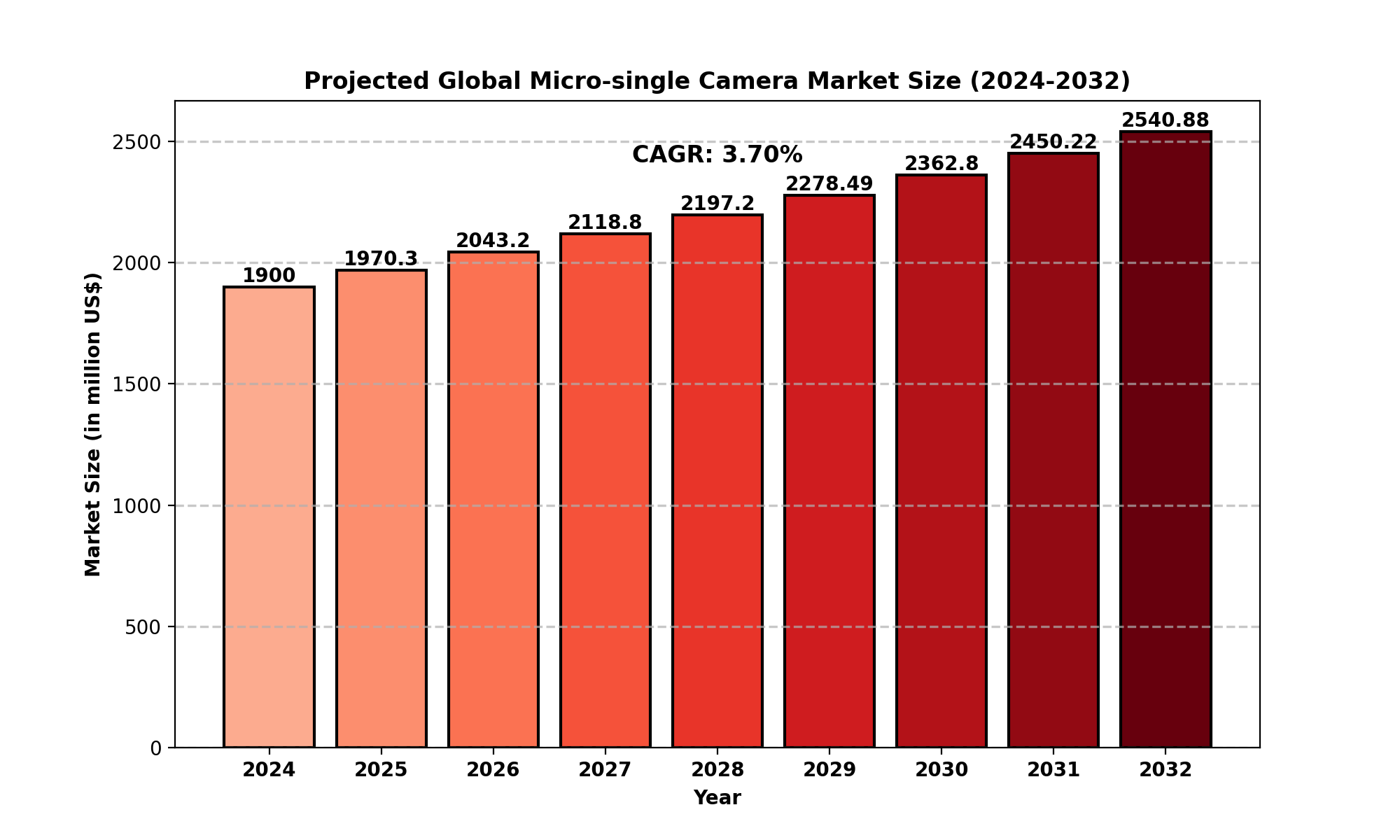TOP CATEGORY: Chemicals & Materials | Life Sciences | Banking & Finance | ICT Media

A micro-single camera, often referred to as a mirrorless camera, is a type of digital camera that incorporates the ability to change lenses but does not have a mirror reflex mechanism, unlike traditional digital single-lens reflex (DSLR) cameras. This category of cameras is known for being smaller, lighter, and more compact than DSLR cameras while still offering high-quality imaging capabilities. The term "micro" refers to the smaller size of the camera compared to a typical DSLR, while "single" highlights the fact that these cameras have a single, interchangeable lens. The popularity of micro-single cameras has surged in recent years due to their versatility, portability, and high-quality performance, making them a favorite among both professional photographers and hobbyists.
Key Features of Micro-Single Cameras
Compact Size: These cameras are much smaller and lighter than traditional DSLR cameras, making them portable and easy to carry around.
Interchangeable Lenses: Like DSLRs, micro-single cameras allow users to swap out lenses to suit different photographic needs.
No Mirror Mechanism: Unlike DSLRs, micro-single cameras use an electronic viewfinder or the LCD screen for composing images instead of a mirror reflex system.
High Image Quality: Despite their compact size, micro-single cameras offer high-quality images, often on par with professional DSLR models.
Micro-single cameras typically feature advanced autofocus systems, the ability to shoot video in high resolutions, and various manual control options, appealing to both professional photographers and amateurs. As technology advances, manufacturers continue to enhance their functionalities, contributing to the camera's increasing market popularity.
Market Size
The global micro-single camera market was valued at USD 1.9 billion in 2024 and is expected to grow to USD 2.54 billion by 2032, representing a compound annual growth rate (CAGR) of 3.7% during the forecast period.
The market's expansion is driven by several factors, including technological innovations, rising consumer demand for high-quality photography in compact devices, and the increasing popularity of content creation, particularly on social media platforms.
Historical Market Growth
Historically, the market for micro-single cameras experienced rapid growth, driven by the transition from traditional point-and-shoot cameras and DSLR cameras to more versatile and portable options. Advancements in sensor technology, lens design, and image processing have also contributed to their growing adoption.
Projected Growth Trends
The micro-single camera market is expected to continue its upward trajectory due to the growing interest in photography and videography, as well as improvements in camera technology. Consumers' preference for smaller, more portable devices that still deliver professional-grade results will drive the growth of this market. Additionally, the rise of social media platforms like Instagram, YouTube, and TikTok, where high-quality video and photography are highly valued, is contributing to the increased demand for such cameras.

Market Dynamics (Drivers, Restraints, Opportunities, and Challenges)
Drivers
Technological Advancements: Continuous innovation in camera sensors, autofocus systems, and image processing technology is making micro-single cameras more appealing to both professional photographers and casual users.
Increased Demand for Content Creation: With the rise of social media influencers, vloggers, and photographers, the need for high-quality, compact cameras that deliver superior performance is growing.
Portability: Micro-single cameras offer a balance between quality and portability, making them perfect for travelers, content creators, and those who need a high-performance camera without the bulk of traditional DSLRs.
Restraints
High Price Points: Despite the advantages, some micro-single cameras are priced similarly to DSLRs, which may deter budget-conscious consumers. This can limit the market's accessibility to a broader demographic.
Limited Lens Selection: While the selection of lenses for micro-single cameras has expanded, it still lags behind the extensive options available for DSLR systems, which may be a drawback for certain users.
Opportunities
Emerging Markets: Increasing disposable income and growing interest in photography in developing regions provide ample growth opportunities for micro-single cameras.
Integration with Smartphone Technology: The development of camera systems that can seamlessly integrate with smartphones or offer advanced mobile features presents an opportunity to expand the functionality of micro-single cameras.
Challenges
Competition with Smartphone Cameras: The continuous improvement in smartphone cameras, including their ability to shoot high-quality images and videos, poses a challenge to micro-single cameras, particularly among casual users who prioritize convenience.
Battery Life: Some micro-single cameras have relatively shorter battery life compared to larger DSLRs, which could be a challenge for professionals who rely on extended shooting sessions.
Regional Analysis
North America
The North American market for micro-single cameras is expected to reach USD 526.99 million by 2024, with a growth rate of 3.17% CAGR over the forecast period from 2025 to 2032. The U.S. is a significant contributor to this market, driven by the high demand for content creation, professional photography, and videography.
Europe
Europe is home to some of the largest players in the micro-single camera market, including companies like Canon, Sony, and Nikon. The demand for high-quality photography equipment, particularly in countries like Germany, the UK, and France, contributes to the robust growth of the market in this region.
Asia-Pacific
Asia-Pacific represents one of the fastest-growing regions for micro-single cameras. Countries like Japan, South Korea, and China have seen significant technological advancements and a growing consumer base. In particular, Japan is home to major camera manufacturers, further strengthening the region's dominance in the market.
South America and MEA
The micro-single camera market in South America and the Middle East & Africa is comparatively smaller but holds significant growth potential due to increasing middle-class populations and improving access to high-quality cameras.
Competitor Analysis (in brief)
The micro-single camera market is highly competitive, with several key players vying for market share. The leading companies include:
Canon: A major player in the digital imaging space, Canon offers a wide range of micro-single cameras known for their quality and versatility.
Sony: Known for its innovation, Sony's mirrorless cameras feature cutting-edge autofocus technology and excellent video capabilities.
Nikon: With a long history in photography, Nikon’s micro-single cameras provide exceptional image quality and are popular among both professional photographers and enthusiasts.
FUJI: FUJI is recognized for its distinctive design and superior color reproduction, attracting photographers who value creative control.
These companies dominate the market through their technological advancements, product diversity, and global reach. Additionally, smaller players like Panasonic, Kodak, and Leica are also making strides in the micro-single camera space.
Global Micro-Single Camera: Market Segmentation Analysis
This report provides a deep insight into the global Micro-single Camera market, covering all its essential aspects. This ranges from a macro overview of the market to micro details of the market size, competitive landscape, development trends, niche markets, key market drivers and challenges, SWOT analysis, value chain analysis, and more.
The analysis helps the reader to shape the competition within the industries and strategies for the competitive environment to enhance the potential profit. Furthermore, it provides a simple framework for evaluating and assessing the position of business organizations. The report structure also focuses on the competitive landscape of the Global Micro-single Camera Market, introducing in detail the market share, market performance, product situation, operation situation, etc., of the main players, which helps the readers in the industry to identify the main competitors and deeply understand the competition pattern of the market.
In a word, this report is a must-read for industry players, investors, researchers, consultants, business strategists, and all those who have any kind of stake or are planning to foray into the Micro-single Camera market in any manner.
Market Segmentation (by Application)
Personal: This segment caters to individual consumers who use micro-single cameras for personal photography, social media, and content creation.
Commercial: Professional photographers and content creators often use micro-single cameras for commercial purposes, including advertising, professional shoots, and media production.
Others: This category includes specialized uses for micro-single cameras, such as research, education, or niche photography markets.
Market Segmentation (by Type)
Full Frame Camera
Half Frame Camera
Key Company
Canon
Sony
FUJI
Nikon
Panasonic
KODAK
ZEISS
SAMSUNG
Leica
OLYMPUS
Hasselblad
SIGMA
Geographic Segmentation
North America (USA, Canada, Mexico)
Europe (Germany, UK, France, Russia, Italy, Rest of Europe)
Asia-Pacific (China, Japan, South Korea, India, Southeast Asia, Rest of Asia-Pacific)
South America (Brazil, Argentina, Colombia, Rest of South America)
The Middle East and Africa (Saudi Arabia, UAE, Egypt, Nigeria, South Africa, Rest of MEA)
FAQ Section
What is the current market size of the Micro-Single Camera Market?
Which are the key companies operating in the Micro-Single Camera Market?
What are the key growth drivers in the Micro-Single Camera Market?
Which regions dominate the Micro-Single Camera Market?
What are the emerging trends in the Micro-Single Camera Market?
Key Benefits of This Market Research:
Key Reasons to Buy this Report:
Frequently Asked Questions ?
